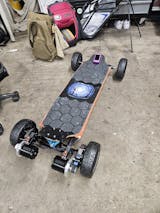How to Avoid Flat Bike Tires
A flat tire is the most common mechanical problem you'll encounter as a cyclist, and since it's unexpected, it can be quite frustrating. But flat tires are a fact of life for cyclists, so it's inevitable you'll experience a flat tire at some point.
There are lots of reasons a bike tire can go flat, with some of the most common of them being punctures caused by sharp objects, rubbed or ripped tire, failure of the valve stem, road hazards such as debris or potholes, inner tube quality, damaged tire liner and more.
While it's impossible to prevent flat tires altogether, there are multiple things you can do to avoid getting them too often. Here are some of the best ways to thorn-proof your bike.
1. Keep a Keen Eye for Hazards
Many flat tires can be avoided if you keep an eye out for hazards on the road ahead. If you find that you're particularly prone to flat tires, you may want to look at your road position — if you use the area close to the curb instead of the regular traffic areas of the roadway, you'll be more likely to get a tire puncture because that is the where all the glass shards and other debris ends up.
2. Check Your Tire Pressure
When inflating your tubes, you need to make sure that the pressure is correct. You can find the recommended tire pressure on the side of the tire. If your tubes aren't fully inflated, the chances of picking up a flat are higher than when your tires are nicely pressurized. Besides using the recommended range to get the proper pressure, you can also gauge the pressure quickly by squeezing the tires. You should feel a small amount of give; the tires have to be firm, but still, not hard as a rock.
3. Use Tire Liners
Tire liners add an extra layer of protection around the inner tube of the tires. They are often easy to install and do a good job of protecting your tires from getting punctures. While they don't guarantee you won't ever get another flat tire, tire liners are cheap and reusable, which means that you can apply them to new tires if they're still in good condition. Nevertheless, keep in mind that they don't provide protection on the sidewall. It's always a good idea to use quality tire liners if you want to preserve your tires' suppleness.
4. Use Tube Sealants
Tube sealants are slime-like products that prevent and repair flat tires that are caused by small puncturing objects. Inject it inside the inner tube, and you'll be protected against punctures up to 3mm in diameter (this might differ depending on the brand). Tube sealants can treat only punctures on the tread area inner tube, and they won't work on sidewall punctures, rim spoke punctures, or "snake bites flats".
The tube sealant should last for the entire life of the inner tube. It doesn't dry out and works on multiple punctures. Plus, many sealants cum with anti-corrosion inhibitors, which are an extra benefit.
5. Buy Puncture-Resistant Tires and Tubes
Puncture-resistant tires and tubes are a good choice if you want your wheels to be protected against shards of glass and other debris without having to deal with installing tube sealant. These tires have a layer of thicker rubber or another kind of protection underneath the tread. This extra layer makes it less likely for sharp items to reach the inner tube.
While puncture-resistant tires are a great choice for training and commuting, they are not ideal for race bikes, as they are generally on the heavier side. You can also opt for self-sealing inner tubes, which can prevent a full-blown puncture even when the tire and the tube have been penetrated. These inner tubes contain a special liquid that finds and plugs small holes that might appear in the inner tube. They are also heavier than regular inner tubes, but they can provide you with some extra peace of mind.
6. Invest in Tubeless Tires
By installing tubeless tires on your bike, you eliminate the chance of any snakebite puncture, where the tube gets caught between the tire and the rim. This is because these tires don't use inner tubes.
To use tubeless tires, you need to make sure you have tubeless-compatible wheel rims, which are not cheap, but the benefits are indeed immense. If you can afford it, tubeless tires allow you to enter the modern age of cycling.
***
The above are some of the basic things to do to avoid flat bike tires as part of your bicycle care. They are valid for all kinds of bikes, including electric bikes, and they can save you a lot of frustration when you're out and about on your bike.






